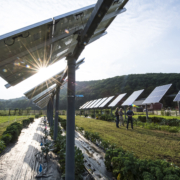Study: Agrivoltaics Create Energy and Agricultural Opportunities for Communities
Agrivoltaics have been shown to contribute to achieving energy and food goals simultaneously through combining agricultural production with energy production, according to a recent report by Clean Technica. The report finds that global agrivoltaic energy production has grown from 5MW in 2012 to 2,900 MW in 2020.
The diverse options available through agrivoltaics can create opportunities for community interests, can reduce land use conflicts, and increase the economic value of farms using agrivoltaic systems, according to the report. A recent study conducted by Oregon State University estimates that the U.S. could meet renewable energy goals while saving water and creating a sustainable food system by converting just one percent of American farmland to agrivoltaics.
The report highlights multiple benefits for solar developers utilizing agrivoltaics. These benefits include reduced installation costs, increased PV performance, building closer links with agricultural land, reduced upfront risk, reduced legal risk and marketing opportunities. Land managers may also benefit from developing agrivoltaics by potentially extending growing seasons and water-use reduction, according to the report.
To learn more about the details of each of these identified benefits, read the article here.

 NREL, Dennis Schroeder
NREL, Dennis Schroeder
